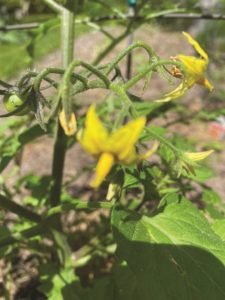Everyone has a story about tomatoes. They are plants of family, of memories, of passed-down secrets, like old recipes. Whenever tomato growing comes up, there is nearly always a personal story to follow.
“Tomato plants are one of my favorite smells in the world,” says Emma Stevens of Eastham. Their aroma awakens memories. “They smell like nostalgia,” Emma says.
Sofie Ackerman of Amherst followed with her tomato story: “When I was younger, on my daily run, I would pass a farm with a big greenhouse full of tomato plants. I would stop and eat them,” she says, adding, “I only picked the ones that had fallen on the floor — so I felt like I was doing a good thing.” Over time, she says, she must have eaten hundreds of them.
Tomato stories are always told with that far-off look, eyes gazing unfocused, as if at something in the distant past.

My tomato story is that I like to sit in the garden on a hot day, feeling the warm soil under me, that smell of nostalgia in the air, eating sun-warmed cherry tomatoes plucked from heavy branches. A tomato ripened in the sun and eaten warm is the most fully expressed tomato. It is how I believe a tomato wants to be eaten.
Here is the story of the tomato itself. The tomato plant, Solanum lycopersicum, originated in western South America and Central America. The Aztecs used tomatoes in their cooking, and it has been, and remains, a culinary staple throughout the regions of its origin. It was called tomatl by the Nahuatl of Mexico and its current name is derived from that word.
Hernán Cortés brought seeds taken from Montezuma’s gardens back to Europe. The plant belongs to the deadly nightshade family, and its fruits were initially thought to be poisonous and were not eaten. Instead, tomatoes were treated as an ornamental curiosity, bred and cultivated to be colorful. Once the misconception was sorted out, they became an integral part of European cuisine. In Italy, they were called pomi d’oro (golden apples) and they got the name pommes d’amour (love apples) in France. Now, they are cultivated everywhere there is a warm enough growing season, and they’re eaten in nearly every part of the planet.
Growing tomatoes is a way of welcoming summer. Here, gardeners know that when the nights start to be free of frost, and the air feels soft, it is time to start your seeds indoors. Tomatoes still remember their days in the Central American sun. They like warmth. Start them in the soil of starter pots and keep them in your warmest, sunniest window. Once nighttime temperatures are above 50 degrees Fahrenheit, they can be moved outside and planted in the ground.
It is too late for all that at this point in the season. Now is the time to buy starts at a nursery or roadside stand — or collect some from friends who had all their seeds sprout and now have an abundance to share.

I grow my tomatoes in a pot for the first few weeks so I can control their watering and fertilizing. When moving them into the ground, replant them deep in the soil, burying them all the way up to their first few branches. This way they will produce roots along their stem. This helps them start their tomato-producing life with a deep, strong root system.
Most tomatoes tend to do best grown in the ground, where their roots can spread freely. That way, too, there is plenty of room to create a support system, with cages or stakes. But there are varieties suited for containers; many of the cherry tomatoes take well to patio planters. I have had great success with large cloth grow-bags. The roots hit the edge of the bag, and instead of circling, as they would in a pot, they branch back and create a massive, fibrous system, allowing for very effective nutrient and water absorption.
What tomatoes really want is sun and heat. Remember their origins. Tomatoes have that memory too, deep in their biology. They love to cook in the hot sun, where they can release that glorious, memory-laced scent, draw in the sun’s energy, and turn it into warm, juicy fruit.



